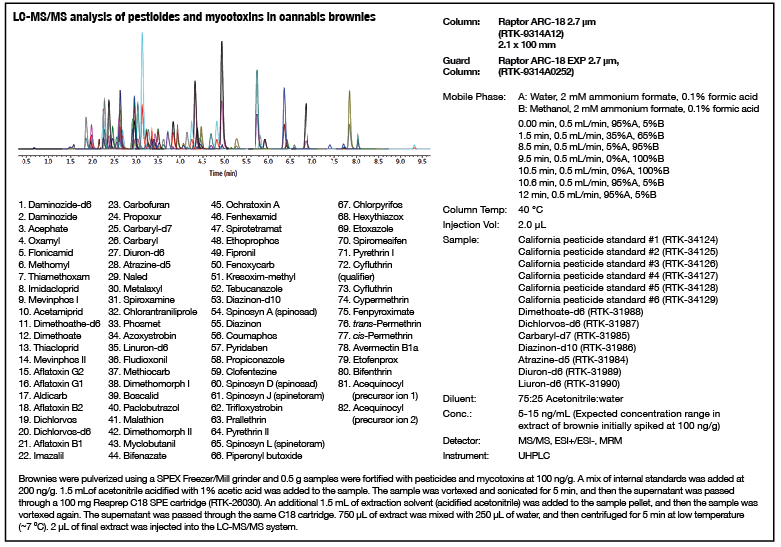Posted by Chrom Tech on 15th Oct 2025
Pesticide and Mycotoxin Analysis in Cannabis Brownies
Ensuring the safety of cannabis-derived edibles such as brownies requires precise and dependable analytical testing for both pesticides and mycotoxins. These contaminants pose potential health risks to consumers, and accurate detection is essential for maintaining product safety and regulatory compliance. Because cannabis brownies contain complex matrices—such as carbohydrates, fats, and other organic compounds—specialized chromatographic methods are required to ensure accurate quantitation and reproducibility.
Why Method Optimization Matters
Edibles like cannabis brownies are among the most commonly consumed forms of cannabis products, but their diverse ingredients can interfere with standard chromatographic workflows. For this reason, developing validated and matrix-specific analytical methods is critical. Restek has developed optimized strategies for pesticide and mycotoxin analysis tailored to complex matrices similar to brownies using both LC-MS/MS and GC-MS/MS instrumentation.
These methods have shown excellent linearity, accuracy, precision, and low limits of quantitation (LOQs), making them ideal for laboratories analyzing edibles and infused products. The approach provides a reproducible foundation for other cannabis-based food products with similar matrix interferences.

Chromatographic Techniques for Cannabis Edibles
LC-MS/MS is widely used for pesticide and mycotoxin quantitation due to its high sensitivity and selectivity. It effectively separates and identifies trace contaminants within complex food matrices. Restek’s Raptor ARC-18 column provides fast, reliable separation with excellent peak shape for challenging analytes.
GC-MS/MS complements LC-MS/MS by targeting volatile and semi-volatile compounds, such as certain pesticides and residual solvents. Restek’s Rxi-5ms capillary column delivers robust, low-bleed performance ideal for multi-residue analysis. Combining both methods allows laboratories to achieve comprehensive contaminant screening with high confidence in results.
Method Benefits
- Improved Accuracy: Optimized for high-fat, high-carbohydrate matrices common in brownies and other edibles.
- Reproducibility: Consistent performance across multiple runs and analysts.
- Efficiency: High-throughput workflows support increased sample volume without sacrificing precision.
- Regulatory Compliance: Supports strict state and federal testing guidelines for pesticide and mycotoxin limits in cannabis products.
Reliable Supplies for Analytical Cannabis Testing
To achieve reproducible results in cannabis analysis, laboratories must pair optimized methods with high-quality consumables. Chrom Tech provides a complete selection of chromatography and mass spectrometry supplies—including vials, 96-well plates, syringe filters, and solvent waste containers. For laboratories expanding their cannabis testing capabilities, these products support clean, consistent, and contamination-free workflows.
For assistance with selecting LC-MS or GC-MS consumables for cannabis analysis, contact Chrom Tech to connect with our technical experts.
Frequently Asked Questions
Why is pesticide and mycotoxin testing important in cannabis edibles?
Testing ensures consumer safety by detecting harmful contaminants that can survive the cultivation, extraction, and baking process. Regulatory agencies require this testing to verify product safety before sale.
Which analytical methods are most effective for testing cannabis brownies?
How can labs reduce matrix interference in cannabis edible analysis?
Using optimized sample preparation methods, high-quality columns, and proper filtration techniques minimizes interference from fats and carbohydrates while improving reproducibility.

